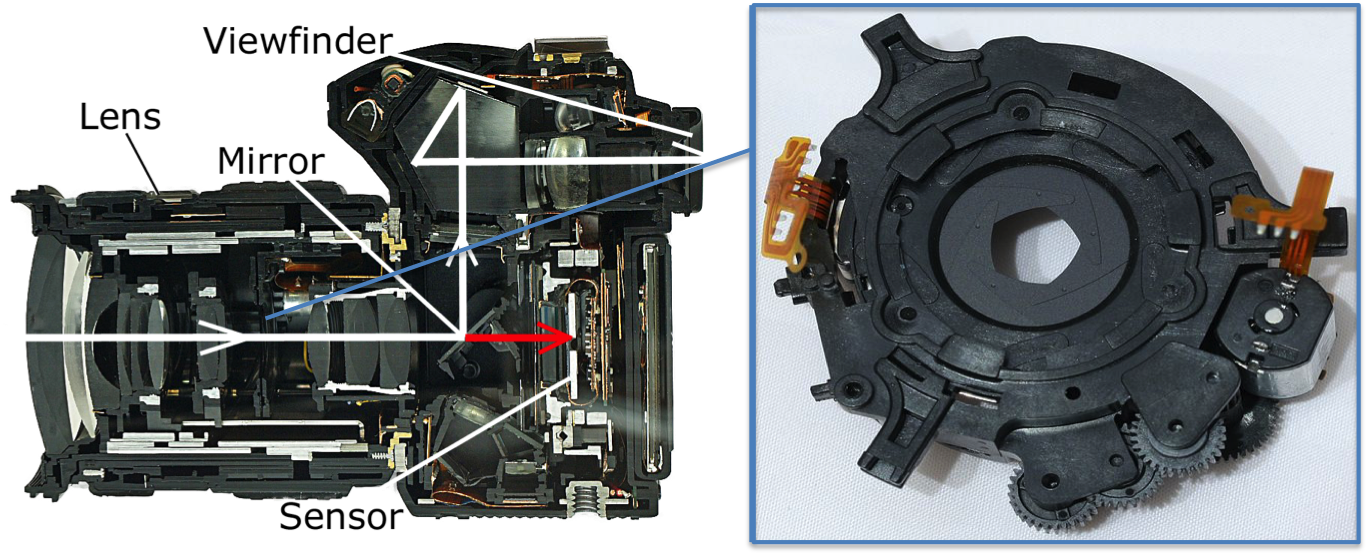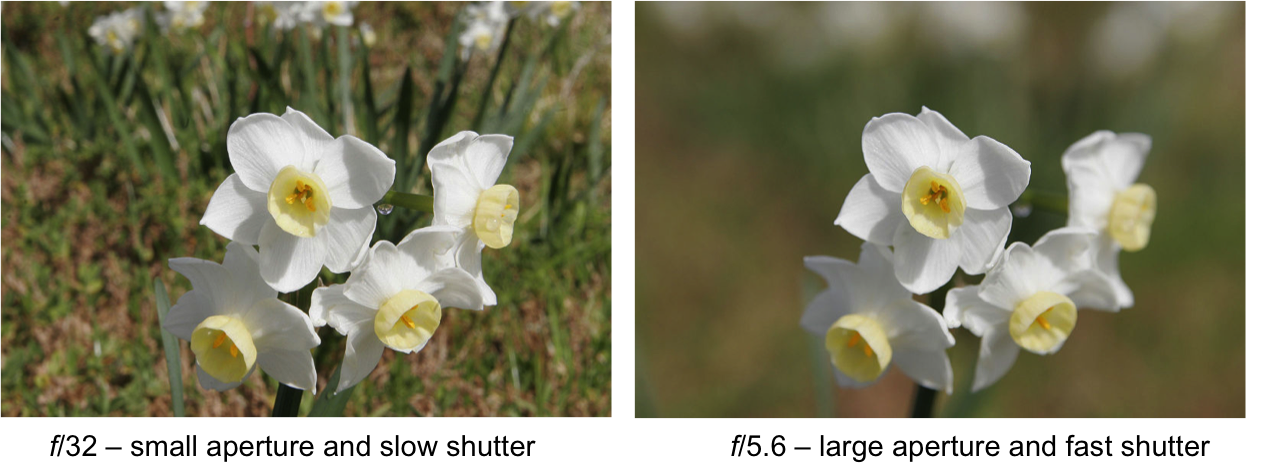In optics, an aperture is simply an opening through which light travels. An optical system typically has many openings, or structures that limit the ray bundles (ray bundles are also known as pencils of light). These may be the edge of a lens or mirror, or a ring or other fixture that holds an optical element in place, or may be a special element such as a diaphragm placed in the optical path to limit the light admitted by the system. In general, these structures are called stops, and the aperture stop is the stop that primarily determines the ray cone angle and brightness at the image point.
In some contexts, especially in photography and astronomy, aperture refers to the diameter of the aperture stop rather than the physical stop or the opening itself. For example, in a telescope the aperture stop is typically the edges of the objective lens or mirror (or of the mount that holds it). One then speaks of a telescope as having, for example, a 100 centimeter aperture. In astrophotography, the aperture may be given as a linear measure (in inches or mm) or as the dimensionless ratio between that measure and the focal length. In other photography it is usually given as a ratio.
Apture in photography. A photographic lens usually make use of a device called diaphragm as the aperture stop (see Figure 1), whose opening can be adjusted to control the amount of light reaching the film or image sensor. The aperture size, combined with shutter speed, regulate the film’s or image sensor’s degree of exposure.
 Figure 1, Diaphragm aperture in a DSLR lense and its close up image.
Figure 1, Diaphragm aperture in a DSLR lense and its close up image.
The lens aperture is usually specified using an f-number in the form of f/xx, the ratio of focal length to effective aperture diameter. A lower f-number denotes a larger aperture opening which allows more light to pass through. The photography term “one f-stop” refers to a factor of √2 (approximately 1.41) change in f-number, which corresponds to a factor of 2 change in the apture area, thus intensity of light passing through. Typical ranges of apertures used in photography are about f/2.8–f/22, covering 6 stops, which may be divided into wide, middle, and narrow of 2 stops each.

Figure 2, Diagram of decreasing aperture sizes (increasing f-numbers) for “full stop” increments (factor of two aperture area per stop)
The specifications for a given lens typically include the maximum and minimum aperture sizes, for example, f/1.4–f/22. In this case f/1.4 is the maximum aperture (the widest opening), and f/22 is the minimum aperture (the smallest opening). The maximum aperture opening tends to be of most interest, and is always included when describing a lens. This value is also known as the lens “speed”, as it affects the exposure time. The aperture is proportional to the square root of the light admitted, and thus inversely proportional to the square root of required exposure time, such that an aperture of f/2 allows for exposure times one quarter that of f/4.
Zoom lenses typically have a maximum relative aperture (minimum f-number) of f/2.8 to f/6.3 through their range. High-end lenses will have a constant aperture, such as f/2.8 or f/4, which means that the relative aperture will stay the same throughout the zoom range. A more typical consumer zoom lens will have a variable maximum relative aperture, since it is harder and more expensive to keep the maximum relative aperture at long focal lengths. f/3.5 to f/5.6 is typical of a common variable aperture range in a consumer zoom lens. On the other hand, the minimum aperture does not depend on the focal length – it is limited by how narrowly the aperture closes, not the lens design – and is generally chosen based on practicality: very small apertures have lower sharpness due to diffraction, while the added depth of field is not generally useful, and thus there is generally little benefit in using such apertures. Accordingly, digital single-les reflex camera (DSLR) lens typically have minimum aperture of f/16, f/22, or f/32, while large format may go down to f/64, as reflected in the name of Group f/64.
Application. Apture size in a camera determines the depth of field, which describes the extent to which subject lying closer to or farther from the actual plane of focus appears to be in focus on the image. Reducing the aperture size (larger f number) increases the depth of field. This is because the aperture and focal length of an optical system determine the cone angle of a bundle of rays (i.e. how collimated the admitted rays are) that come to a focus on the image plane. If the aperture size is small, then highly collimated light rays are admitted, resulting in a sharp focus at the image plane. A wide aperture admits uncollimated rays, resulting in a sharp focus only for rays coming from a certain distance. This means that a wide aperture results in an image that is sharp for things at the correct distance only.

Figure 3, Photographs of an object taken with different apture size (shutter speeded adjusted to obtain the same level of exposure). Small aperture size leads to larger depth of view (left), while larger apture size reduces the depth of view (right).
Besides the depth of field, the aperture also determines how many of the incoming rays are actually admitted and thus how much light reaches the image plane (the narrower the aperture, the darker the image for a given exposure time). In the human eye, the pupil is the aperture. Aperture priority is a semi-automatic shooting mode used in cameras. It permits the photographer to select an aperture size and let the camera to decide the shutter speed and sometimes also ISO sensitivity of the image sensor (digital cameras) for the correct exposure. This is also referred to as Aperture Priority Auto Exposure, A mode, AV mode (aperture-value mode), or semi-auto mode.
Apertures in other fields. The biological pupil of the eye is its aperture in optics nomenclature. The iris is the diaphragm that serves as the aperture stop. Refraction in the cornea causes the effective aperture (the entrance pupil in optics parlance) to differ slightly from the physical pupil diameter. In astronomy, the diameter of the aperture stop is a critical parameter in the design of a telescope. Generally, one would want the aperture to be as large as possible, to collect the maximum amount of light from the distant objects being imaged. The size of the aperture is limited, however, in practice by considerations of cost and weight, as well as prevention of aberrations. In light microscopy, the word aperture may be used with reference to either the condenser (changes angle of light onto specimen field), field iris (changes area of illumination) or possibly objective lens (forms primary image).
